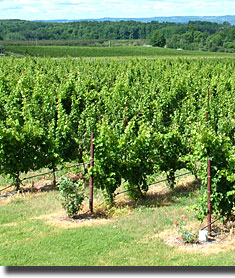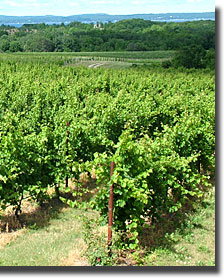|
California market, a major coup for the first Michigan winery to
achieve such placement.
Ralph’s
supermarkets feature Gold Medal winners from this particular competition
throughout its chain, and as a result of their showing, CGT has sold 720
cases for distribution in 130 Ralph’s stores in the LA area, with an eye
towards future placement in the San Francisco Bay area as well.
And as if that weren’t enough to make everyone at CGT giddy with
delight, there was the inaugural
Riesling Rendezvous, held at Chateau St. Michelle in
Woodinville, Washington on June 24-26 under the joint sponsorship of
that winery and
Dr. Loosen, one of the foremost Riesling producers in Germany.
Conceived as “an event to bring together leading Riesling experts and
producers to explore the versatility of Rieslings from around the
world,” more than a few eyes were raised in surprise by the Chateau
Grand Traverse selections being poured, as recorded in the following
testimonials:
“Categories aside, there were some wonderful
Rieslings on display (220 of them, to be exact), and some were from
surprising places. Chateau Grand Traverse in Michigan, for example, is
making terrific Rieslings in a variety of styles." -
Laurie Daniel, San Jose Mercury News
“Perhaps the biggest discovery at the
conference for most attendees was the excellence of the Michigan wines -
and that Chateau Grand Traverse produces about 65,000 cases.”
-
Paul Franson, Wines & Vines
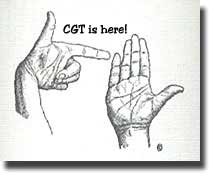 “Riesling’s
our main thing (and) it’s really boom times for Riesling right now,”
Sean told us, adding that they’re striving to produce even more. About
75% of the estate’s 105 acres of vineyards is planted to that varietal
(the oldest vineyards are 33 years of age), and this year they’ve
contracted for around 50 tons from the
Leonard and Eddie Ligon’s farm. CGT purchased the Zafarana
Vineyards and added that fruit to their 2006
harvest, and there are another 20 acres of new vines on a recently
purchased 40-acre Old Mission Peninsula plot, planted to almost every
clone of Riesling that Sean could get his hands on, as well as 1½ acres
devoted to a Gruner Veltliner experiment. “Riesling’s
our main thing (and) it’s really boom times for Riesling right now,”
Sean told us, adding that they’re striving to produce even more. About
75% of the estate’s 105 acres of vineyards is planted to that varietal
(the oldest vineyards are 33 years of age), and this year they’ve
contracted for around 50 tons from the
Leonard and Eddie Ligon’s farm. CGT purchased the Zafarana
Vineyards and added that fruit to their 2006
harvest, and there are another 20 acres of new vines on a recently
purchased 40-acre Old Mission Peninsula plot, planted to almost every
clone of Riesling that Sean could get his hands on, as well as 1½ acres
devoted to a Gruner Veltliner experiment.
“We’re starting to understand what’s going on with our vineyards,”
O’Keefe explained, referring to the soil in northern Michigan, and
particularly on the Old Mission Peninsula, which can change dramatically
within very short distances, due to the glacial activity of prehistoric
times.
The winery is in the process of undergoing a $3-3 ½ million expansion,
with a projected goal of producing 100,000 cases a year. 1,200 and 2,400
liter foudres have been purchased for the production of Auslese-type
wines; some are traditional, having been prepared to remove any oak
flavors and some have a light toast. Sean told us that the lightly
toasted ones will probably be used for Chardonnay,
Pinot Blanc and Pinot Gris for the first few years “until we
feel that the flavors (are) right.”
We spent about three hours over two days talking and tasting with
O’Keefe; the first day was devoted to whites, while on the second, we
explored some reds. During the opening session, we sampled some tank
pours of Riesling, Pinot Blanc and Chardonnay that are slated for
blending; then we sat down to taste through the current pale lineup. It
should be noted that we liked what we tasted of the whites well enough
to resample over the next two weeks in order to flesh out our notes, and
without exception, our initial enthusiasm was reconfirmed, if not
exceeded.
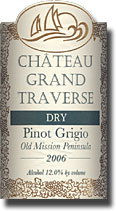 2006
Chateau Grand Traverse Old Mission Peninsula Pinot Grigio, 12% alc.,
$14.99: If I’d have been told even a year ago that I’d not only be
drinking Michigan Pinot Gris/Grigio, but actually buying and enjoying
it, I’d have just laughed and poured another glass of Muscadet. But
after tasting impressive efforts from
Left Foot Charley and
Chateau Fontaine, this one comes along and gives further
evidence that this is a varietal that can thrive on either peninsula,
Leelanau or Old Mission. Medium straw in color, with fairly generous
aromatics of apple and grapefruit laced with banana (“No, we did NOT use
71B yeast,” Sean chortled...) that echo and expand on the palate
with a subtle mineral
undertone. Medium to medium-full bodied and almost plump in the mouth;
Sean describes the fruit as “globby,” and I think we’re talking about
the same thing there. Good acidity, presence and length, and both
food-and-warm weather friendly; enjoy it with the catch-of-the-day from
any Michigan lake or just sip and savor on a sultry summer afternoon or
evening. Find this wine 2006
Chateau Grand Traverse Old Mission Peninsula Pinot Grigio, 12% alc.,
$14.99: If I’d have been told even a year ago that I’d not only be
drinking Michigan Pinot Gris/Grigio, but actually buying and enjoying
it, I’d have just laughed and poured another glass of Muscadet. But
after tasting impressive efforts from
Left Foot Charley and
Chateau Fontaine, this one comes along and gives further
evidence that this is a varietal that can thrive on either peninsula,
Leelanau or Old Mission. Medium straw in color, with fairly generous
aromatics of apple and grapefruit laced with banana (“No, we did NOT use
71B yeast,” Sean chortled...) that echo and expand on the palate
with a subtle mineral
undertone. Medium to medium-full bodied and almost plump in the mouth;
Sean describes the fruit as “globby,” and I think we’re talking about
the same thing there. Good acidity, presence and length, and both
food-and-warm weather friendly; enjoy it with the catch-of-the-day from
any Michigan lake or just sip and savor on a sultry summer afternoon or
evening. Find this wine
(The following selection is NOT one of those that O’Keefe tasted with
us, but notes are included here for what we think are good reasons;
first, it’s one that we’ve enjoyed on several occasions over the past
year or so; second, it’s still available at retail in the Detroit area
and finally, it serves to provide some focus to the ’05 version that he
did pour.)
 2004
Chateau Grand Traverse Old Mission Peninsula Ship of Fools White Table
Wine, 40% Pinot Gris, 35% Pinot Blanc, 25% Chardonnay, 12% alc., $13.99:
One of Sean’s “specialty wines,” sporting an individualized label with a
humorous etching, this whole cluster pressed medium straw offers tart
green apple and grapefruit flavors and aromas underscored with a nice
chalky minerality and subtle herbal undertones; medium to medium-full
bodied, bone dry and yet rich at the same time, with excellent
intensity, bracing acidity and good length on the finish. One of the
better dry Michigan whites that we’ve had, this pairs very well with a
grouper sandwich at the downtown Traverse City restaurant
Hannah, and it’s nice enough that I bought more when we got back
home, because it’s getting very scarce around Traverse; the 2005 is the
current vintage available at the winery. Speaking of which… Find this wine 2004
Chateau Grand Traverse Old Mission Peninsula Ship of Fools White Table
Wine, 40% Pinot Gris, 35% Pinot Blanc, 25% Chardonnay, 12% alc., $13.99:
One of Sean’s “specialty wines,” sporting an individualized label with a
humorous etching, this whole cluster pressed medium straw offers tart
green apple and grapefruit flavors and aromas underscored with a nice
chalky minerality and subtle herbal undertones; medium to medium-full
bodied, bone dry and yet rich at the same time, with excellent
intensity, bracing acidity and good length on the finish. One of the
better dry Michigan whites that we’ve had, this pairs very well with a
grouper sandwich at the downtown Traverse City restaurant
Hannah, and it’s nice enough that I bought more when we got back
home, because it’s getting very scarce around Traverse; the 2005 is the
current vintage available at the winery. Speaking of which… Find this wine
2005 Chateau Grand Traverse Old Mission Peninsula Ship
of Fools White
Table Wine, 40% Pinot Blanc, 35% Pinot Gris, 25% Chardonnay, 12% alc.,
$13.99: Another medium straw colored blend, with a similar tart
green apple, grapefruit and mineral personality to the ’04, the main
difference being that it’s lower (but not deficient) in acidity; still,
it’s rich, round, food friendly, and, yes, bone dry. Find this wine
Silver Medal - 2007 San Francisco International
Wine Competition
2006 Chateau Grand Traverse Old Mission Peninsula Dry Riesling, 12% alc., $9.99: Medium straw in color, with some subtle floral and lime
nuances that adorn the green apple aromatics, and as this opens and
warms in the glass, an unmistakable note of lanolin emerges; these
impressions all follow through nicely on the palate, underscored with
good minerality and driven along by excellent acidity on a medium to
medium-full bodied frame. The lanolin, usually an attribute more
associated with white Rhônes, doesn’t exactly dominate the personality
of the wine, but it does set a tone and adds a distinctive
characteristic. One of the three best dry Rieslings from Michigan that
I’ve had to date (those from
Wyncroft and
Left Foot Charley being the others), and an excellent QPR value. Find this wine
Gold Medal - 2007 Los Angeles International
Wine & Spirits Competition, CA
Bronze Medal - 2007 San Francisco International Wine Competition
2006 Chateau Grand Traverse Old Mission Peninsula Semi-dry Riesling,
12% alc., $12.99: Medium straw color with a tinge of lemon; modest
perfumed apple and peach aromatics echo and expand dramatically on the
palate with undertones of lime, pine and some nice minerality. Medium
bodied and then some, slightly oily in texture, with good acids and
length; rich, delicious fruit with Kabinett levels of sweetness. All in
all, a very enjoyable Riesling that I will buy more of for personal
consumption. Find this wine
Silver Medal - 2007 Los Angeles International
Wine & Spirits Competition, CA
Bronze Medal - 2007 San Francisco International Wine Competition
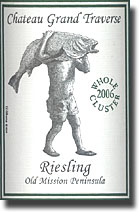 2006
Chateau Grand Traverse Old Mission Peninsula Whole Cluster Riesling, 12% alc., $14.99: Another one of Sean’s special projects, and my
favorite of the CGT Rieslings, this pale straw colored wine was made
from hand selected grape clusters pressed whole without destemming or
crushing, which then underwent a very cool (42º F) fermentation to draw
the process out. Off dry, at under 1% residual sugar, it dishes out
rich, generous red and green apple flavors and aromas shaded with a hint
o’ lime and good minerality; it’s a bit more than medium bodied, with
good weight and beautiful concentration. I love this wine. Find this wine 2006
Chateau Grand Traverse Old Mission Peninsula Whole Cluster Riesling, 12% alc., $14.99: Another one of Sean’s special projects, and my
favorite of the CGT Rieslings, this pale straw colored wine was made
from hand selected grape clusters pressed whole without destemming or
crushing, which then underwent a very cool (42º F) fermentation to draw
the process out. Off dry, at under 1% residual sugar, it dishes out
rich, generous red and green apple flavors and aromas shaded with a hint
o’ lime and good minerality; it’s a bit more than medium bodied, with
good weight and beautiful concentration. I love this wine. Find this wine
Gold Medal - 2007 Los Angeles International
Wine & Spirits Competition, CA
Bronze Medal - 2007 San Francisco International Wine Competition
2006 Chateau Grand Traverse Michigan Late Harvest Riesling, Harvest
Sugar 21.0º Brix, 4.6º Brix residual sweetness, 10.5% alc., $14.99:
This wine is hugely popular in the Michigan marketplace, and CGT
produces over 10,000 cases a year, but despite being released in the
spring, it’s an even bet that there won’t be much around by Christmas.
This year’s model is medium straw in color, and offers apple, peach and
apricot flavors and aromas with Spatlese levels of sweetness and enough
minerality to add another dimension and keep it from being just another
simple sweet white from northern Michigan. Rich, round and crisp, with
good acids and length, this certainly would serve well as an
after-dinner sipper, but for me, it is a wine to pair with some spicy
Thai or Indian cuisine, or perhaps even better, some fresh pan fried
northern Michigan trout. Best of all, a recent taste of the 2002 shows
that it has the stuffing to age and develop with some time in the
cellar, IF you can keep your hands off of it now. Find this wine
Gold Medal - 2007 Los Angeles International
Wine & Spirits Competition, CA
Gold Medal - 2007 San Francisco International Wine Competition
Another one that Sean didn’t pour for us, because there was none left at
the winery, but we made other arrangements.
2005 Chateau Grand Traverse Old Mission Peninsula Edelzwicker, 12.8%
alc., $12.99: This medium straw colored “Noble Blend” of
Gewurztraminer, Pinot Gris, Pinot Blanc and Muscat is made in the
classic Alsatian style, and after winning Platinum at the 2007 Los
Angeles International Wine & Spirits Competition, it sold out in one day
at CGT. Fortunately, there’re still ample quantities left here in the
Detroit area, so I ordered some up for my department, brought one home
to try, and my better half and I quite liked what it has to offer. It
definitely shows a Gewurztraminer-kind-of-personality, somewhat
toned-down due to the inclusion of the other varietals, but still giving
that distinctive “peachy-litchi” flavor profile, shaded with some subtle
melon, apricot, mineral and a soft herbaceousness. Off-dry is the best
way to describe this; it almost gives the impression of sweetness on
entry, but it’s not a sweet wine by any means. Medium to medium-full
bodied, with a smooth texture that belies deceptive acidity and good
length on the finish. Nice stuff here, and another one that I’ll be
taking more home myself. Find this wine
Platinum Medal, Best of Category - 2007 Los
Angeles International Wine & Spirits Competition, CA
2005 Chateau Grand Traverse Old Mission Peninsula Dry Gewurztraminer,
500 ml, 13.5% alc., $10.99: Medium straw in color, with an
effusively floral peachy, litchi nose, and with plenty more of the same
on the palate, along with a note of rainwater, excellent minerality and
acidity. Good weight and very good varietal character, being quite dry
and quite delicious. We liked this well enough to bring four home from
the winery.
Find this wine
Gold Medal - 2007 San Francisco Chronicle Wine
Competition, CA
“I’m not saying that we can’t
make good reds, it’s just not in our long-term interests to keep
planting Pinot Noir and Cabernet Franc.”
After tasting through the whites, we let Sean get back to work and went
looking for some deep water to swim in (Haserot Beach on the Old
Mission Harbor served very well in that regard). The next day, we
returned late in the morning to see what CGT is doing with reds, and
while they are quite pleasant and enjoyable, they don’t move us in the
same way that the whites do, and O’Keefe seemed to agree, telling us,
“I’m not saying that we can’t make good reds, it’s just not in our
long-term interests to keep planting Pinot Noir and Cabernet Franc.”
Here are our snapshot impressions of what he poured for us:
2005 Chateau Grand Traverse Old Mission Peninsula Gamay “Limited
Bottling,” $10.99: Ruby garnet in color and made in an easy quaffing
style reminiscent of Beaujolais Villages; medium bodied, with bright
black and tart cherries, some decent depth and a little earth
underneath. A nice red quaffer. Find this wine
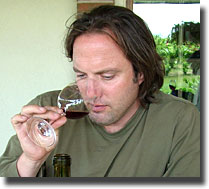 “Now,
Pinot is something we’re still working on,” Sean said as he poured us a
taste of the following wine. “We veer between the Germanic style and
what I call the old Spaniard style that our winemaker (Bernd
Croissant) does. We keep them fairly long in the barrels,
more than most people do, so they’re usually more mature when we release
them. We’re buying new red wine fermenters that remove the seeds. I
think the green seeds contribute just a little bit in the lighter style
of Pinot; in Pinot, ANY little thing is going to show up just like in a
Riesling, so, we have to be a little more careful. The vineyards are
finally getting mature now, which has helped a lot. I don’t think we’re
going to beat out the Willamette Valley any time soon on a consistent
basis, but that’s fine.” “Now,
Pinot is something we’re still working on,” Sean said as he poured us a
taste of the following wine. “We veer between the Germanic style and
what I call the old Spaniard style that our winemaker (Bernd
Croissant) does. We keep them fairly long in the barrels,
more than most people do, so they’re usually more mature when we release
them. We’re buying new red wine fermenters that remove the seeds. I
think the green seeds contribute just a little bit in the lighter style
of Pinot; in Pinot, ANY little thing is going to show up just like in a
Riesling, so, we have to be a little more careful. The vineyards are
finally getting mature now, which has helped a lot. I don’t think we’re
going to beat out the Willamette Valley any time soon on a consistent
basis, but that’s fine.”
2004 Chateau Grand Traverse Old Mission Peninsula Pinot Noir Reserve,
$15.99: An even lighter ruby garnet color than the Limited Bottling
Gamay, with a fragrant cherry, berry and plum personality; medium
bodied, rich and round. Pretty nice stuff; saw all French oak, about 20%
new, 20% 1st year, 20% 2nd year, 20% 3rd year and 20% 4th year. About
this one, Sean explained, “We’ve been moving to older oak; we used to do
all new oak and it just couldn’t handle it." Find this wine
“Typically, we usually
like to drink this about six years after it
was made, it’s usually perfect right about then. For Gamay,
that’s kind of odd, but…”
2004 Chateau Grand Traverse Old Mission Peninsula Gamay Noir
Reserve, $15.99: This ruby garnet colored wine saw both French and
American oak, and they pay compliments to the cherry and berry on the
nose; darker on the palate, with some added black pepper, medium body,
good acids, mild tannins and nice depth. Not an earth shaker, but
perfectly enjoyable for what it is. Find this wine
2005 Chateau Grand Traverse Old Mission Peninsula Pinot Noir Barrel
Sample: Sean admitted that he didn’t know the exact provenance of
this sample, and that it came from a random 2-year-old barrel, but it
was actually quite tasty. It looks like rosé and smells like
Spätburgunder
(German Pinot Noir), with nice cherry and raspberry flavors and aromas
and good intensity. As we sampled this, O’Keefe had the following
observations:
“I think of Charlie Edson at
Bel Lago and I
like his philosophy. His thought is that a lot of guys are shooting for
color at all cost, and it’s actually diminishing the wine. I’m pushing
Riesling, I’m not going to be the Jihadist (for) light Pinot Noirs in
the country, but you know, Burgundy gets away with it, depending on what
region you’re at. I mean, obviously, they have the nuance and the
history and the networking to sell it, but if we could develop a style
here where we concentrate just on flavors and delicate aromas and not
get so hell bent on color... I don’t think we could out-Oregon or
Russian River Valley those guys, and when we try to, it invites
chicanery, with blends of Chamborcin and things to boost the color. I
don’t know if that’s going on here, but I’ve had it in other regions. So
I think Charlie’s on to that, and it’s not a popular style yet, but I
think it’s something that if you just keep at it and at it like we did
with Dry Riesling, eventually, people are going to come around.”
2005 Chateau Grand Traverse Old Mission Peninsula Gamay Noir Reserve
Barrel Sample: Drawn from another random barrel, Sean speculated
that it was from newer oak, and the toasty flavors and aromas seemed to
bear that out; ruby dark garnet color, with toasty oak, toast, coffee
and what Kim describes as explosive cherry in the mouth. Good tannins
and depth.
2006 Chateau Grand Traverse Old Mission Peninsula Cabernet Franc
Ligon Vineyard Barrel Sample: Ruby dark garnet color, with
attractive cherry, berry and currant flavors and aromas. Sean said at
the time that, to him, this still smelled just off the skins, like it
was just pressed, adding that is the first vintage that they’ve worked
with this Ligon fruit. “In the future, we’ll probably be doing more of a
traditional Bordeaux blend with Merlot and Cab Franc. It really comes
down to when we taste it and make the call. When we get these small
quantities, we’ll probably make 300 cases of this at the most, 350
maybe. If we think it’s that good on its own, we’ll make a hundred
cases, maybe 200... I won’t know until next year.”
A view of one of Chateau Grand
Traverse's oldest vineyards and the west arm of
Grand Traverse Bay in the background
While we talked and tasted, Sean addressed one of the most formidable
difficulties that any winegrower in the Grand Traverse area faces, that
being the shorter growing season, telling us that it is most crucial
during the period up until bloom. “We rush the bloom; where most people
have a month and a half (to) two months, we have bud break… it depends
on the year, usually in mid-May, and we get bloom usually in the second
(or) third week in June, so we really have a short time; but then from
bloom through veraision through harvest, it’s longer and longer in(to)
your growing season. The problem is not the quality of the grapes or the
ripening of the grapes if you have the right variety plan; it’s that we
have a lot less time. The Germans have a whole month and a half to prune
everything down and get everything shoot-positioned right.”
O’Keefe says that one way to deal with the shorter season is through a
combination of employing more workers and the use of “ingenious
trellising” to improve quality. He also reiterated the importance of
growing the right varieties for the region. “We most likely always have
cool falls, with the exception of 2005 and 1998, and Riesling loves
that. It can get down to 35 degrees at night, and when it warms up in
the morning, it starts photosynthesizing again. Do that to Cabernet
Sauvignon or other grapes and they just (say), ‘All right, I know what’s
going on here, I’m shutting down to survive and I’m not putting any(thing) into sugar production.’ We really are at the very tips of the
warm areas where we can grow reds here. Pinot Noir is a little
different; it ripens earlier, so we avoid the cool temperatures.”
While it’s not their main focus, CTG is redoing their red program, and
according to Sean, will probably bring in an assistant winemaker in the
next year or two who knows cool climate reds so that they can take them
to the next level. “But it’s never going to be our main thing,” he
admitted, “it’s for Michigan consumption only, I mean really for our
market. If somebody wants it, fine, but I strongly believe that the
white wines from here are the ones that people anywhere would (say),
‘Yes, I like that,’ as long as they’re priced right.”
Frankly, from everything that we tasted (some selections multiple
times), those whites are right there, right now, and yes, the reds are
coming along nicely, and all offer excellent value at their price
points. After 33 years in operation, Chateau Grand Traverse SHOULD
be among the very best producers in Michigan, and they are. The
2006 whites are certainly the product of an exceptional growing year,
but still, there is a consistency of quality that spans multiple
vintages that gives us great optimism for the future at CGT, and we'll
be following their progress closely. Stay tuned for further
reports...
Reporting from Day-twah,
Bastardo

Other Recent Wine Explorations
Bastille Day in Day-Twah
A Mess
o' Reds
Mr.
Dan's Wild Ride
Red Wings
and Red Rhônes Playoff Diary-Round Three
A Bunch O' Whites (& One
Pinky)
Left Foot Charley
Red Wings & Red Rhônes
Playoff Diary - Round Two
Better Red Than Dead
Red Wings & Red Rhônes
Playoff Diary - Round One
Back to the August 2007 Index
Back to the Underground Index
Back to the Top


© George Heritier August, 2007
|
 “Now,
Pinot is something we’re still working on,” Sean said as he poured us a
taste of the following wine. “We veer between the Germanic style and
what I call the old Spaniard style that our winemaker (Bernd
Croissant) does. We keep them fairly long in the barrels,
more than most people do, so they’re usually more mature when we release
them. We’re buying new red wine fermenters that remove the seeds. I
think the green seeds contribute just a little bit in the lighter style
of Pinot; in Pinot, ANY little thing is going to show up just like in a
Riesling, so, we have to be a little more careful. The vineyards are
finally getting mature now, which has helped a lot. I don’t think we’re
going to beat out the Willamette Valley any time soon on a consistent
basis, but that’s fine.”
“Now,
Pinot is something we’re still working on,” Sean said as he poured us a
taste of the following wine. “We veer between the Germanic style and
what I call the old Spaniard style that our winemaker (Bernd
Croissant) does. We keep them fairly long in the barrels,
more than most people do, so they’re usually more mature when we release
them. We’re buying new red wine fermenters that remove the seeds. I
think the green seeds contribute just a little bit in the lighter style
of Pinot; in Pinot, ANY little thing is going to show up just like in a
Riesling, so, we have to be a little more careful. The vineyards are
finally getting mature now, which has helped a lot. I don’t think we’re
going to beat out the Willamette Valley any time soon on a consistent
basis, but that’s fine.” 

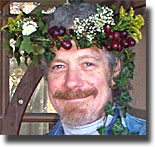
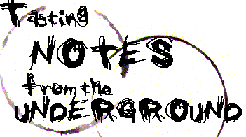

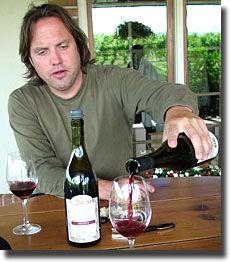 A
few weeks back, Kim and I took the opportunity to return to the
Traverse City area for a few days, and we further parlayed that into
a visit with Sean O’Keefe,
Vice President and Specialty Winemaker
(right) at
A
few weeks back, Kim and I took the opportunity to return to the
Traverse City area for a few days, and we further parlayed that into
a visit with Sean O’Keefe,
Vice President and Specialty Winemaker
(right) at
 “Riesling’s
our main thing (and) it’s really boom times for Riesling right now,”
Sean told us, adding that they’re striving to produce even more. About
75% of the estate’s 105 acres of vineyards is planted to that varietal
(the oldest vineyards are 33 years of age), and this year they’ve
contracted for around 50 tons from the
“Riesling’s
our main thing (and) it’s really boom times for Riesling right now,”
Sean told us, adding that they’re striving to produce even more. About
75% of the estate’s 105 acres of vineyards is planted to that varietal
(the oldest vineyards are 33 years of age), and this year they’ve
contracted for around 50 tons from the



